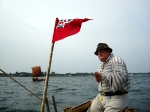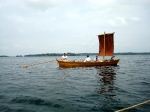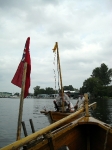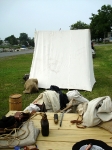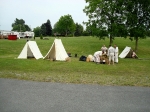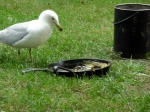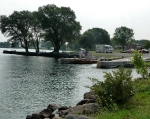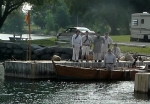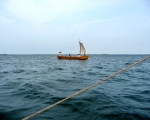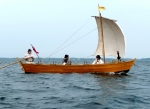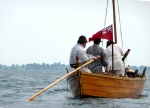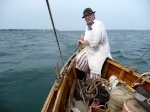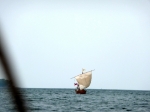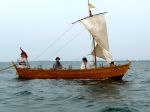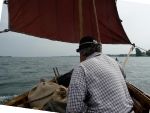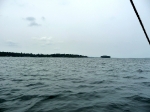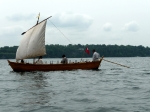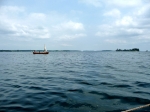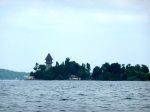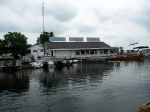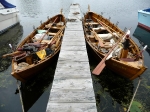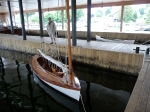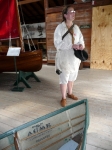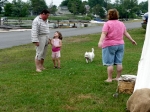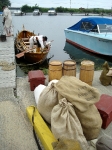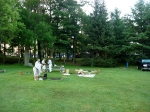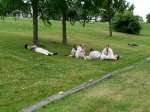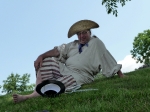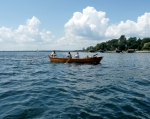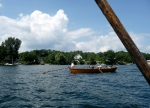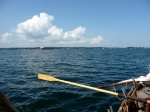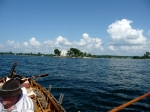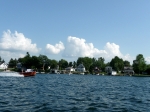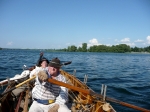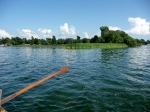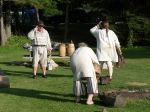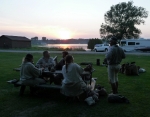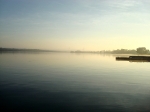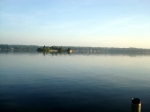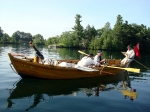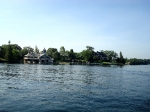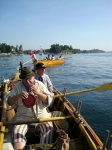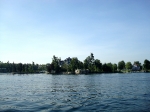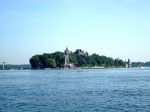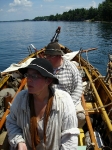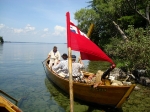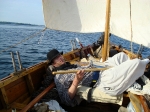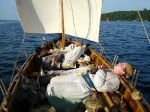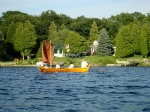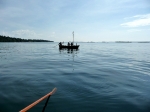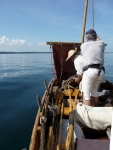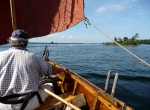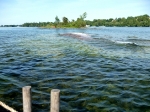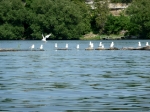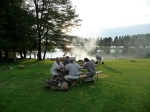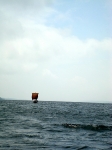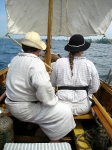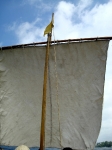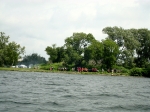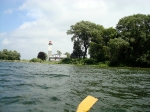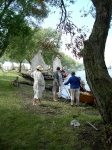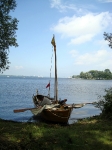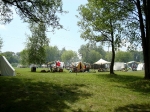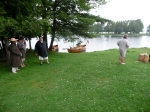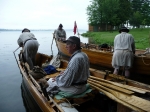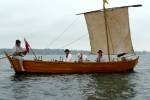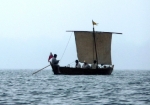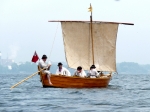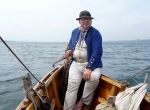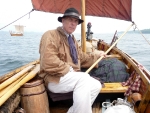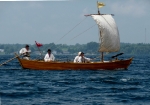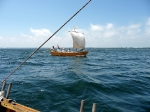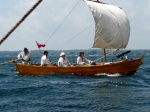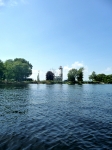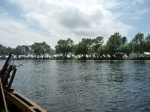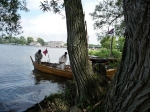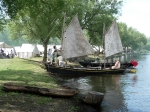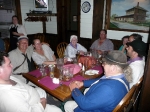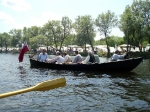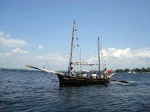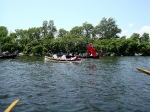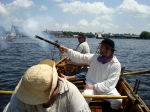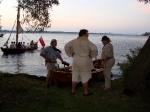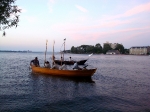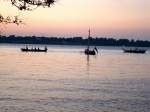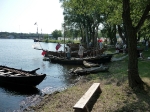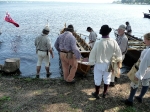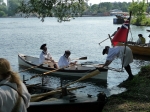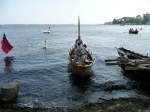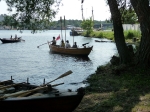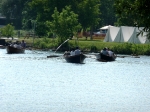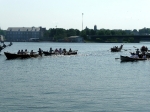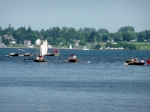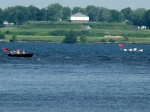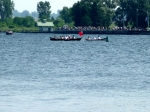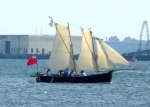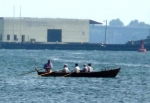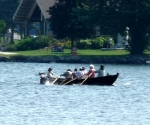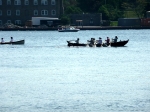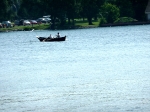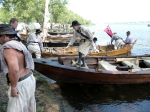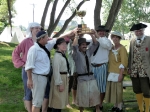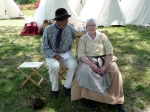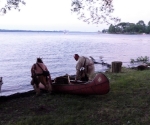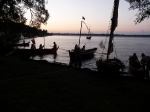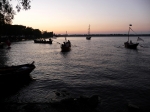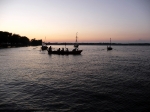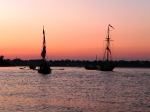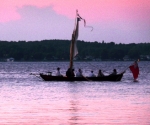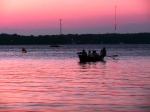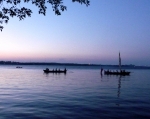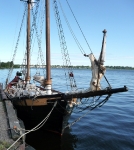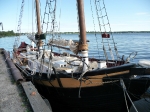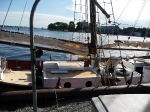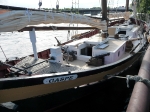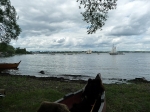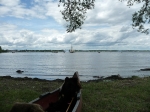Also known as ‘The Big Row, 2010’
All photos were taken by Bill Manthey or by Charlie Schroeder and are copyright to them. Text is by myself, David Manthey.
Monday, 12 July 2010 – Cedar Point State Park, Clayton
This year’s Big Row took place on the Saint Lawrence River. Heather and I had scouted out various spots in May, and I had done a bunch of planning. To the best of my ability, everything was ready for the row, though I wish I had had time to make some new ash oars.
Although there are only six rowers for the whole trip (plus one additional on Friday), we are taking two boats. This has the virtue that we have plenty of space, and that we are more of a spectacle. It has the drawback that in headwinds we will take that much more effort to move. I didn’t think that six or seven people and all of their camping gear would be comfortable in a single boat (even if we were to take just the Bobbie G), thus my decision for two boats. Only time would tell if this was a good choice or a foolish one.
Kevin, Rick, Heather, Monty and I met at the Farm around 12:30 today. We hooked up the boat trailers to Kevin and Rick’s pickup trucks, loaded various gear into the boats, and started off in convoy. The drive from the Mabee Farm to the Saint Lawrence River took around 4 hours, including a few necessary stops.
We arrived at Cedar Point State Park, checked in, made sure all necessary fees were paid for those who would arrive after us, and found our campsite. I had selected a site next to the large parking lot so that we could keep an eye on the boats during the evening. We gradually set up tents and squared away our gear.
Around 7 p.m., Reb and Bill arrived. Heather and Monty departed (they aren’t going on the row, they were just here for support). For dinner we had some hot dogs from Rolf’s Pork Store and some corn of dubious pedigree. After dinner we sorted things as best we could. We also spent much time talking and catching up with each other.
A little after 9 p.m., Charlie arrived. I hadn’t met him yet, and, while he sounded very promising, it was a relief to see that he would be a fine addition to the crew. He had flown in from California and rented a “Smart Car”. The Smart Car is a ludicrous mode of transportation. We made sure he had a place to sleep, had appropriate clothing, and a way to keep necessary items dry.
Throughout the evening, various people in the campground came by to look at our boats. Even on the trailers they attract a fair amount of attention. Naturally, we talked to everyone, some of whom seemed quite enthused.
Tuesday, 13 July 2010 – French Creek Marina, Clayton
We breakfasted on eggs and bulk sausage, packed up our gear, and headed over to Cape Vincent. The town of Cape Vincent has a nice municipal boat launch just to the east of their breakwater. We pulled in, immediately launched the boats, and started loading them and rigging them out.
We have our own sail for the DeSager, and we are borrowing a sail from one of Reb’s friends for the Bobbie G. Rigging out the DeSager was quick work; the Bobbie G took a bit longer as I had to bend on all of the appropriate lines to the sail, plus improvise a yard from our spare steering oar. We’ve used this sail before, and it is a good sail, so this went well.
We started with Kevin, Rick, and Bill in the DeSager. They are equipped with the fir steering oar, plus the long and the short ash oars. Reb, Charlie, and myself are in the Bobbie G. We have the nice ash steering oar, the medium ash oars, and the dreadful long fir oars.
Under way by 9:45 or so, which isn’t bad considering how much effort always starts a Big Row. Our vehicles are parked here and should be okay.
The wind was from the south on our starboard beam. We almost immediately hoisted sail. Throughout the day the wind would vary from one point in front of the beam to around four points aft of it, mainly staying 1 to 2 points aft. This is not the best point of sailing for the bateaux, but it does let us sail rather than row. It would prove to be a fair amount of work for the steersmen and the bowsmen with the whisker booms.
As we were loading up we saw a small freighter taking on a pilot. One of our friends was very worried about the wakes from freighters. I didn’t have much concern on this score, as commercial vessels are generally operated in a rational, predictable manner. The pleasure craft wakes were of greater concern, but still not too significant.
The wind was quite fresh, often around 15 knots. Our speed averaged a little over 3 miles an hour, with bursts up around 5 or 6. When a gust would occur, the steersmen would have to lean into to their oars and the bowsmen would wrestle with the whisker booms.
I know I’ve mentioned it in past years, but the use of whisker boom is a great improvement over trying to fuss with a bowline on our boars. I had put new ash shafts on the boat hooks (also called gaffs). Last year, the closet rod dowels we were using for shafts flexed far too much. This year, the ash handles would prove far better. They still flex, but not to the same alarming degree as soft wood, and, moreover, after flexing, the shaft is not permanently floppy. It is still called “sailing on a bowline”, even though we aren’t using a bowline per se. The tip of the gaff gets hooked into the windward clew of the sail, and the bowsman then holds the gaff so that the sail draws appropriately. When a gaff is used in this manner it is called a whisker boom.
We covered the day’s distance very quickly. We watched the wind-turbine covered Wolfe Island give way to smaller islands. At times we could see Canada; at times we couldn’t. The scenery is beautiful, and the name “1000 Islands” is fairly obviously based on the small and large islands everywhere.
We ate snacks and lunch. Far sooner than I really expected we spotted Cedar Point State Park where we had spent Monday night. I sounded my horn in case any of the people we had talked to were watching, but we didn’t approach the shore. The other boat assumed this was the signal for Rum Call and issued a half gill of rum to each of the crew.
The wind moderated and nearly died as we reached Bartlett Point, the point of land just before Clayton. We dowsed our sails and put out the oars and started to row.
I had arranged to stay at a marina with campsites that is located on the south side of the road bridge in Clayton. As we neared the bridge, it became obvious that we would have to unstep the masts in order to fit under it. The Bobbie G had the better of the two masts (the one with the pennant staff affixed to it), and this unstepped easily. The DeSager‘s mast stuck, however, and Rick was unable to pull it out of the step block. I leapt into the DeSager, and the two of us managed to wrestle the mast out of the step. This took far more effort than even steering had taken during the day.
We rowed in to the marina. I sent Reb to find out where we would be berthed, but she came back reporting that the woman at the marina store was asking her questions she couldn’t answer.
Sure enough, the fact we were sail boats and had come under the bridge confused them somewhat. The fact we didn’t have any wheeled vehicles confused them. Eventually we had two slips for the boats and had paid for a ludicrous four campsites (since we had four tents). Aside from paying for too many campsites, the marina was a perfectly good place to stay.
After resting in the shade and drinking shrub, Kevin, Reb, and Bill wandered off to the Antique Boat Museum. The rest of us gradually set up camp. I ended up taking a short nap.
The museum goers came back around 6 p.m. Around the same time, Heather showed up via car with Monty and our not-quite-four-year-old niece Ruby. They stayed a short time, just to let Ruby see the boats, then headed away again.
Kevin made a nice dinner based on period recipes for a Dutch hutspot. His dish had beef cooked with ginger and artichokes along with a side dish of rice and cooked spinach. We were all hungry, despite mostly sailing today, and ate the tasty food with much relish.
Distance today: around 14 miles, 13 under sail, 1 under oars.
Wednesday, 14 July 2010 – Grass Point State Park, Alexandria Bay
Up with the sun. Unfortunately, there is a northeast wind blowing, and the river has whitecaps. I listened to the VHF weather radio, and it claims the wind will die off around noon and then come back up from the south-southeast.
We have a leisurely breakfast of eggs and bacon. Kevin saved some of the bacon grease for tonight’s dinner.
Very slowly, we pack up camp. With the wind blowing 15 to 20 knots, we have no incentive to go out on the water. Naturally, everyone is champing at the bit to get going, though in our experience, we know this to be a poor option.
The morning drags by. We watch a few flags, trying to convince ourselves of the right action. Should we row against the nasty headwind or should we stay put? In the shade of a tree on the side of a hill, the wind seems quite moderate and that we should go. On top of the small hill or looking at the water tells another story.
We tell stories. We play farkle, a dice game, using our frying pan as a playing surface. We eat lunch. We watch the wind. We tell stories. Time drags.
Around quarter to one we decide to head out. Reb counsels that we should continue waiting, but the rest of us are too impatient. The wind has lessened to a mere 10 to 15 knots. Out we go.
We change the crews somewhat. Kevin, Rick, and Charlie are in the DeSager. Reb, Bill, and myself are in the Bobbie G. We row out under the bridge and the wind hits us well.
It is very slow rowing out past the town of Clayton. It seems to take forever to get to the point of land at the corner of French Creek and the Saint Lawrence River. Bill is working too hard, so I have him steer and I row.
The DeSager is doing okay, but the Bobbie G is having trouble making way, mostly due to the use of the damn Douglas fir oars. Reb has switched to a medium ash oar, which is too short to give good propulsion in the Bobbie G. I continue to try to use a long fir oar, which wastes far too much energy in flexing the oar and puts far too little in moving the boat.
We row into the wind. Many power vessels dart back and forth. We row into the wind some more. Clayton gradually drops astern. We row into the wind. In the distance we can see the bridge for Route 81, but there is no way we are getting to it today.
Every time we pause rowing, we are swept backwards from our goal. It is discouraging, as we feel we can’t stop, can’t rest, can’t even slow down lest we lose what little distance we’ve covered.
After hours of rowing into the wind, we decide that we will stop at Grass Point State Park. This is a mere five miles from where we started, but we are struggling with the wind. After deciding this, the remaining mile and a half doesn’t seem as bad, though we go just as slowly.
We pass lots of little islands. Much as its name implies, Grass Point is indeed covered in grass. We row out past the point of land, on the other side of which we can spot the state park’s docks. We row to the docks, still in the wind.
We arrive just before 6 p.m, having been on the water for five hours and only covered that many miles. We are tired.
I pay for two boat slips, and we reposition the boats to them. Rick and I troop off to the entrance station for the park to pay for a campsite. This is tediously far away. Everyone at the campground is wonderfully friendly.
We come back to the boats, drink some shrub, and move to our campsite. A friendly fellow helps lug some of our gear to our camp. Lots of kids and adults stop by and ask questions. We are surrounded by a series of campsites with people from the same extended family having a big group vacation. Reb shares shrub with some of the them, after which we have to give out the recipe.
Kevin makes a dinner of chicken with onion sauce and potatoes. He is disappointed that his sauce isn’t as thick as he’d like. We don’t care, as it is delicious and we are hungry.
At the edge of dark, a large group of teenage boys (and a few others) arrives at our campsite. They ask intelligent questions, listen to some of our stories, then go and look at the boats. One of them sounds like he would really love to join us, but his parents aren’t present to give their permission so we have to refuse.
We turn in just after dark.
Distance today: around 5 miles, all under oars. Total distance: around 19 miles, 13 under sail, 6 under oars.
Thursday, 15 July 2010 – Jacques Cartier State Park, Brier Hill
In the middle of the night I wake up to hear Bill making a strange hissing sound. There is a skunk rummaging in our camp. We thought we had all of our food in barrels, but there is still one burlap bag with some rolls in it, and the skunk is trying to get into it. The skunk is somewhat frustrated, as it is used to plastic bags that tear easily, and the burlap sack is not doing so. After a brief scare of the skunk pointing its tail at Rick, the skunk wanders away. I fall back asleep.
Up early. We have a quick breakfast of eggs and sausage, then load up the boats. The wind is dead calm, and we push off at 7:30 a.m. A few of the teenage boys who talked with us last night see us off.
We switch out the oars so that the DeSager has the medium and short ash oars and the Bobbie G has the long ash oars. This makes the Bobbie G much faster. We also trade off some of the crew, starting with Reb, Rick, and myself in the Bobbie G. This, along with the better oars, gives the Bobbie G too much speed compared with the DeSager, and we swap Charlie for Rick to try to balance things. This seems to work well enough for the day.
Rowing without a wind is a joy compared to the headwinds of yesterday. The river is beautiful. We work our way under the big highway bridge along Wellsley Island. We pass never so many small islands. We can take breaks and rest and not lose way.
The crew is much happier, and it shows in the cheerfulness of rowing. The day is hot, however, and we have to make sure we all drink enough water.
We see osprey nests, some with osprey chicks. We watch an osprey catch a large fish and bear it away. We see other birds diving and catching smaller fish.
We row by the resort town of Alexandria Bay. It is much less busy than Clayton was yesterday. I don’t know if this is because of the time of day or because it is just less busy. We see a variety of small ferries and tour boats; they are relatively sedate compared to the average pleasure craft.
We pass all manner of expensive houses, plus a modest number of small dwellings. We pass Boldt Castle, an elaborate facility built around 1900 but never finished. It is an interesting tourist attraction, but we just row on by.
I’m delighted with our progress. By 11 a.m. or 11:30 we have reached Kring Point State Park, which had been our intended destination yesterday. We are doing great, and food and rum keeps the rowers happy.
A small power boat approaches us, steered by a fellow who is a fourth grade teacher. He asks all sorts of questions, then motors away. He comes back with two young women (his nieces), asks more questions, then motors away again. He comes back a third time with a camera. We can out-row his trolling motor but are no match for his outboard.
At some point we make a quick ‘natural’ break on Indian Point. It seems far too populated to do this here, but we are about to cross the mouth of Chippewa Bay and the next opportunity will be quite some time later.
The day continues to heat up. Despite consuming vast quantities of water and shrub, continual applications of sunscreen, and wetting our hats and neckerchiefs frequently, we feel like we are wilting. There isn’t a breath of wind.
Just after we passed Chippewa Bay, around 3:30 or 4 p.m., I noticed a flag on the shore showing the merest hint of a southwesterly wind. It was just a 2 knot puff. I asked, “Do you think we should hoist sail?” Before I had even finished asking the question, Reb responded with an emphatic “Yes.”
We stepped our mast, waited for DeSager to do the same, then hoisted sail. It barely filled, but we started to move at all of a mile an hour or so.
We drifted along under the slightest of breezes, headed in the right direction and not rowing. We had already rowed 24 miles, and were quite tired. With the enervating sun, the rowers were glad for a break. The wind was so mild that I feared we wouldn’t get to our desired campsite before nightfall, though I knew we could row if we had to. No one wanted to augment the sailing with rowing, however, so we continued to drift along.
Occasionally the wind would die for five or ten minutes. Less frequently, it would rise to 5 or 6 knots. Mostly, it held around 2 or 3. Our entire focus switched to waiting for puffs of wind.
Gradually we covered distance. The Saint Lawrence has some current, though the wind had completely countered it yesterday. Today, without us rowing, it might have been the bulk of our movement.
Oak Point had a flag that stood out as if it had 5 to 10 knots of wind, though we never received so much as we went by it. The wind was fresher aloft and quite variable below. We used what we got.
In light airs, the DeSager outdistanced the Bobbie G. In heavier gusts, the Bobbie G would surge forward.
Finally, Jacques Cartier State Park came into view. We rounded the point of land, spotted the campground docks, and, even better, spotted Dean at our campsite. I had selected a site that was secluded as far behind the point as possible and with river-front access. We rowed the last few hundred yards to our campsite.
We pulled the boats up on to the land, secured our painters to the trees, then started unloading. I made a dinner of ham-scouse (lobscouse made with ham), which seemed like a vast quantity of food. Everyone seemed to like it well enough, though, as always, hunger makes the best sauce.
Various people in the campground came by to see us. There was one group in modern gear that had rowed a small rowboat (the Ruth Agnes B) quite a distance. They were also headed to Ogdensburg.
We went to bed, drunk with fatigue.
Distance today: around 30 miles, 24 under oars and 6 under sail. Total distance: around 49 miles, 19 under sail, 30 under oars.
Friday, 16 July 2010 – Ogdensburg
A slow morning, both due to the previous day’s efforts and due to rain. We had some rain overnight, and heavy rain off and on this morning. More ominous, though, was the thunder and lightning, much of which sounded as if it was just south of us. The wind is from the southwest, though, which is ultimately promising.
We ate another breakfast of eggs and sausage. It is amazing how much one eats after working hard the previous day. We thought we had vast reserves of sausage, but it turned out to only be moderately generous.
The rain tapered off, the thunder abated, and we gradually struck camp and loaded the boats. As we were working on this, the park superintendant came by and hassled us about the cannons mounted in the boats. This was annoying, but, since we knew and were following all appropriate laws, it amounted to nothing. Still irksome.
We launched under grey skies and light rain around 10 a.m. or so. We started under oars, but soon hoisted sail. Dean joined the Bobbie G; otherwise the crews were the same as yesterday.
Throughout the next few hours the wind gradually increased, staying mostly from the southwest along with some strong fluky gusts from the southeast. The river is comparatively dull here, with only a few very minor islands. We stayed near the American bank, which is mostly lined with large houses. As we neared Ogdensburg, houses gave way to the occasional industrial site.
The miles passed quickly, as we were under sail. The wind was fresh, and the gusts occasioned some tough steering. On one particular gust, the DeSager became very ardent and nosed into the wind. It did this a second time, and then Kevin dowsed the DeSager‘s sail and had the crew start rowing. I had the Bobbie G dowse sail until we could ascertain how the DeSager was doing.
The DeSager had the Douglas fir steering oar, and, during one powerful gust of wind, Kevin had it bent in a nearly 90 degree arc and was unable to steer effectively. Once the DeSager was back under control, they resumed sailing.
Only a short distance after this we could make out a line of small white tents on a point of land. This was the reenactment at Ogdensburg. As we neared the land, we could see reenactors dressed as British troops advanced in a column.
We weren’t sure which side of the point of land we would be camped on, so we dowsed sails and rowed closer. It soon became apparent that we would be camped on the Oswegatchie River side of the point. We weathered the point, spotting the Revenante, the Owl, and several other vessels that had apparently just concluded some action. A few smaller boats were on the river bank.
We rowed to shore, pulling up the boats. The time was only a little after 2 p.m.
All sorts of people we already knew were already present. In the distance we could hear the musket and cannon fire of a battle reenactment. We secured the boats to nearby trees, unloaded a few items, and generally milled around greeting people and being pleased that we had made it.
Before long, Katie, Heather, and Monty showed up. We dispatched the various drivers to go fetch vehicles. Bill and I, not needing to drive, were left to gradually unload the boats and set up camp.
I had last been to the reenactment at Ogdensburg several years ago, and then it had been a very small event. This year it was quite large. I later heard a figure of 700 reenactors, which is big for a French and Indian War event. Our tents were in line with those of other boat crews. There were around a dozen small boats, plus several larger vessels.
Eventually the drivers returned. We all went out to dinner at the restaurant across the street, the Freight House. It was slow because they were overwhelmed with customers due to the reenactment. The food was fair, but not exceptional. After dinner we finished squaring away camp, then each person went off to sleep or socialize as they saw fit.
Distance today: around 14 miles, 13 under sail and 1 under oars. Total distance: around 63 miles, 32 under sail, 31 under oars.
Saturday, 17 July 2010
This morning was easy. Up when we felt like it, breakfast as desired, with coffee provided by the site, and no need to strike camp. Kevin and I went to Officer’s Call at 9:30, which wasn’t very informative for the boats. We have three activities on the boats’ schedule today: a race, a battle, and a night barrage.
The race was scheduled for 10 a.m., but didn’t actually get under way until around 10:30. Only seven or eight vessels participated, even though many more were present.
The race route was out around two red buoys, then back around two green buoys. The green buoys and the nearest red buoy were in the lee of the point of land, but the distant red buoy was in the main channel of the Saint Lawrence River, and was in markedly more choppy water. The wind was a strong southwesterly, and would aid no one in the race.
Both the DeSager and the Bobbie G were in the race. We crewed out the DeSager with intent to win, with Reb, Harvey, Charlie, and Rick rowing, and myself steering. We crewed out the Bobbie G with intent to foil other boats, Kevin steering and a pick-up crew. The boats lined up and the starting gun was fired.
We knew from past races that the boats to watch were the General Arnold and the Chubb, whilst the others that were racing were of much less concern. We immediately cut across the bow of the General Arnold in an attempt to block them from a good start.
We rowed out together toward the first buoy, the DeSager and the General Arnold holding near each other in the front. We had a slight lead, and I steered so that the Arnold would have to either strike the buoy, strike us, or yield. Since the Arnold was steered by a polite woman, they yielded some.
As we entered the main channel, the chop was significant, and the bows were constantly kicking up spray. By the time we reached the second buoy, Arnold had gained a lead that we would never recover. We rounded the buoy with some difficulty, as the current and wind conspired at that point. We then raced downwind and back to the sheltered water, having trouble making out the green buoys.
A long row back, but a solid third for the DeSager. The Bobbie G and several other vessels prudently decided not to venture too far in the heavy water. Although they didn’t cover the entire race, they gave it a good try based on their crews.
There was a fancy award for the General Arnold, which, to no one’s surprise, took first.
After the race we dispersed until early afternoon for the battle reenactment. We crewed out both boats, adding to the crews with some additional reenactors pressed as rowers. Rick manned the cannon in the Bobbie G, and Kevin manned the gun in the DeSager. The battle was much like others we have done, though it was a pleasure to have the schooner Revenant sailing amongst us as a French vessel. Rick really enjoyed firing the cannon.
In the evening, some cannons were placed on the point of land to represent the French fort. Some additional cannons were placed across the Oswegatchie to represent the British siege guns. They had several of the boats row out and add to a barrage against the French battery. We took out the DeSager, fired plenty of rounds, and stayed out until the edge of dark. Afterwards, the town put on a nice fireworks display.
Sunday, 18 July 2010 – Mabee Farm, Rotterdam Junction
Today was even more relaxed than yesterday. Our only scheduled activity was a repeat of the battle in the early afternoon. We just took out the Bobbie G for this.
As soon as the battle was over, we rowed across the Oswegatchie and loaded the boats on their trailers for the trip home. We managed to leave the encampment around 4 p.m. A slow drive home, and the boats were back safe and sound at the Mabee Farm.
A good trip.


